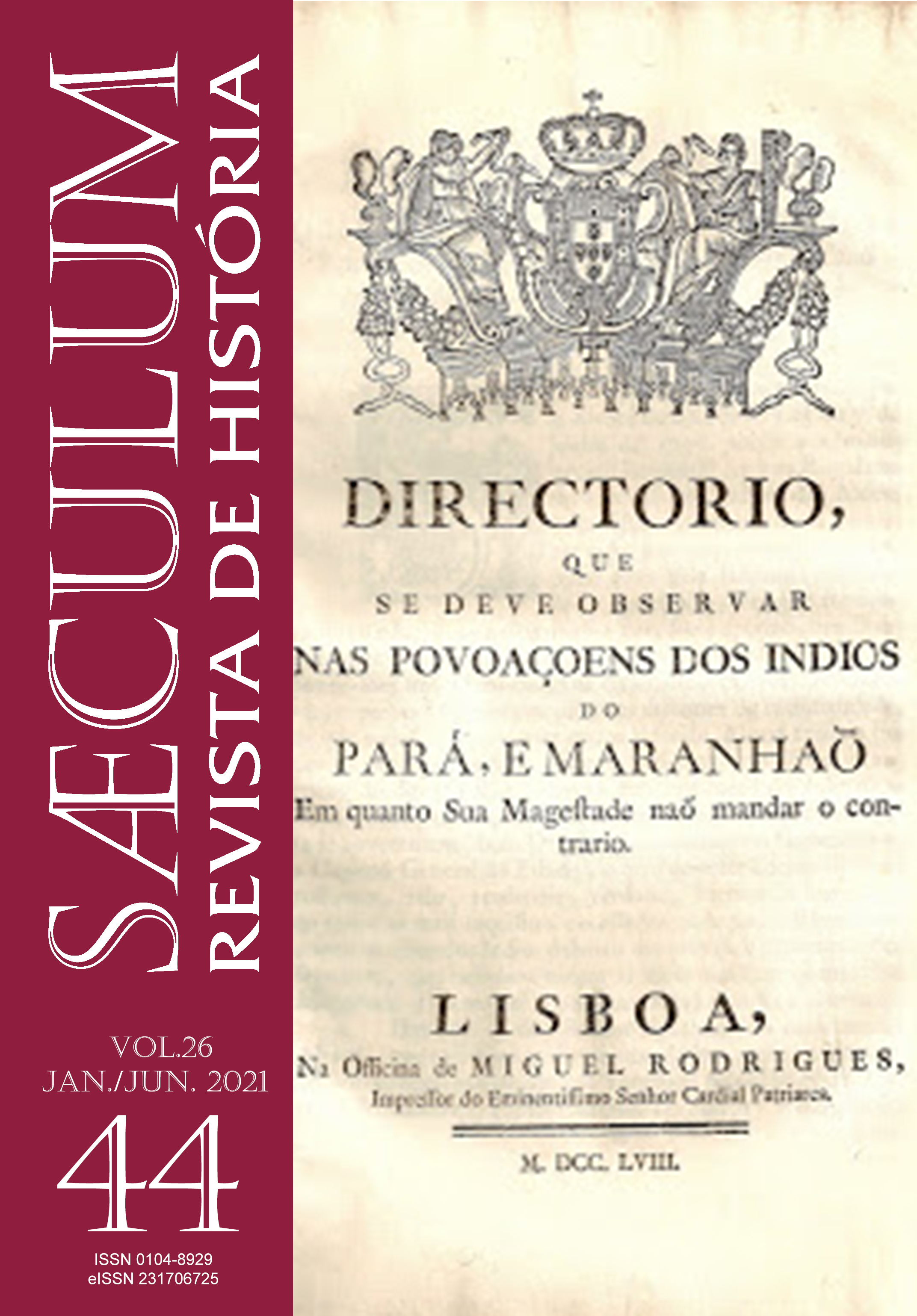The uses of the past to an unprecedented future
The historical production of Triângulo Mineiro’s cities according to the public institutions
DOI:
https://doi.org/10.22478/ufpb.2317-6725.2021v26n44.57657Keywords:
Triângulo Mineiro, Public Institutions, Production of the historyAbstract
Throughout the 19thcentury, the Triângulo Mineiro was occupied with the creation of many villages and towns and some of them became autonomous and, nowadays, this region has 35 cities. The knowledge about the history of most of these cities occurs by official resources like the memorialists and the public institutions works –Secretariat of Education or Culture. In these works, it was noticed there is an intention to recover the past due to aiming the present action and the future projects. From the survey of the specific productions of the municipal public agencies, it found seven cities –Canápolis, Itapagipe, Iturama, Limeira do Oeste, Monte Alegre de Minas, Uberaba e Uberlândia –where they did written works (on different dates) about local history. In these works, it was perceived the ways thatthe city’s past is recovered and presented, as well as the events and the privileged characters and their possible uses. The production is unequal both in quantity and content, but it was observed that in addition to the historical recovery and attempt toform an official version, the public institutions created written works that do the historical recovery and they are part of work of cultural goods survey to encourage actions of appreciation and education of the historical heritage and request greater resources from heritage preservation entities. In examining the texts produced (and disseminated) by public agencies, it is latent that the past is presented as a reference, legitimizing positions, speeches and identities. Also, it is monumentalized because it is like a founder instant and a way which has to be recovered to drive the practice of the social subjects and groups. And from this production, this article discusses the procedures which the past has been mobilized to confirm itself in the process of making of the local memory and identity.
Downloads
References
Arquivo Público de Uberaba. Administração pública em Uberaba: de Capitão Domingos a Anderson Adauto. (2011)
Arquivo Público de Uberaba. Boletim Informativo. n. 1-18. (2000-2018).
Arquivo Público de Uberaba. Catálogo Histórico. (1986-1988)
Arquivo Público de Uberaba. Uberaba: 200 anos no coração do Brasil (2020).
Arquivo Público de Uberlândia. Uberlândia – lugares e memórias (2017).
Casa de Cultura de Canápolis. Histórico do Município de Canápolis. s/d.
MENDONÇA, ALAOR GUIMARÃES: Monumento aos Heróicos Retirantes de Laguna. Publicação da Prefeitura Municipal de Monte Alegre de Minas. (1984)
PEZZUTI, Pedro. Municipio de Uberabinha. Typ. Kosmos. (1922)
Prefeitura Municipal de Iturama. Revista Comemorativa. Assim é Iturama. (1967)
Prefeitura de Iturama. Setor de Patrimônio Cultural. Histórico de Iturama: Pérola do Pontal. (2019)
Prefeitura de Monte Alegre. Departamento de Cultura. Retirada da Laguna. (2012)
Prefeitura de Monte Alegre. Departamento Municipal de Cultura e Turismo. Patrimônio Cultural. Um retrato de Monte Alegre de Minas. (2009)
Prefeitura Municipal de Itapagipe. Plano municipal de Cultura. Inventário Turístico. (2020).
Prefeitura Municipal de Iturama. Cinquentenário de Emancipação Política. (1998)
Prefeitura Municipal de Iturama. Iturama Ilustrada. (1992)
Prefeitura Municipal de Iturama. Iturama. 108 anos de história e 57 anos de emancipação. (2005)
Prefeitura Municipal de Iturama. Município de Iturama. (1970)
Prefeitura Municipal de Iturama. Revista comemorativa – 22º aniversário de Iturama. (1970)
Prefeitura Municipal de Iturama. Revista Comemorativa. Assim é Iturama. (1967)
Prefeitura Municipal de Uberaba. Uma vida, uma história. (Personalidades locais) 2 vol. Uberaba. (1988)
Prefeitura de Limeira do Oeste. Secretaria Municipal de Cultura. Plano de Inventário de Limeira do Oeste. (2004)
Prefeitura de Limeira do Oeste. Secretaria Municipal de Educação e Cultura. Limeira do Oeste em dados. (1996)
Prefeitura de Limeira do Oeste. Secretaria Municipal de Educação e Cultura. Limeira do Oeste. História, Cultura e Arte de um povo. s/d.
Prefeitura de Uberlândia. Secretaria Municipal de Cultura/Diretoria de Memória e Patrimônio Histórico. Patrimônio Cultural – Que bicho é esse? (2014)
ANDERSON, Benedict. Comunidades Imaginadas. Reflexões sobre a origem e a difusão do nacionalismo. São Paulo: Cia das Letras, 2008.
GUIMARÃES, Manoel L. S. História, memória e patrimônio. Revista do Patrimônio Histórico e Artístico Nacional. n. 34, 2011. p. 91-111. Disponível em http://portal.iphan.gov.br/uploads/ckfinder/arquivos/Numero%2034.pdf. Acesso em: 14/09/20/2011
LOURENÇO, Luís Augusto B. O Triângulo Mineiro, do Império à República: o extremo oeste de Minas Gerais na transição para a ordem capitalista (segunda metade do século XIX). Uberlândia: Edufu, 2010.
NORA, Pierre et al. Entre memória e história: a problemática dos lugares. Projeto História. v. 10, p. 7-28, 1993. Disponível em https://revistas.pucsp.br/index.php/revph/article/view/12101. Acesso em: 28/09/20.
POLLAK, Michael. Memória. Esquecimento, Silêncio. Estudos Históricos. v. 2, n. 3, Rio de Janeiro, p. 3-15, 1989.
RÜSEN, Jörn. Razão histórica. Teoria da história: os fundamentos da ciência histórica. Brasília: Ed. UNB, 2001.
Downloads
Published
How to Cite
Issue
Section
License
Copyright (c) 2021 SANDRA MARA DANTAS

This work is licensed under a Creative Commons Attribution-NonCommercial 4.0 International License.
A revista Sæculum permite aos autores a manutenção dos direitos autorais pelo seu trabalho, no entanto eles devem repassar direitos de primeira publicação ao periódico.











